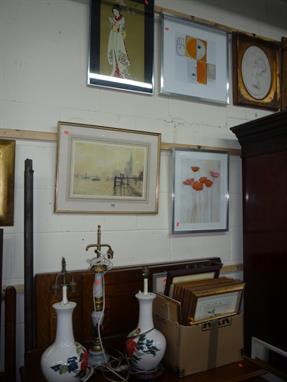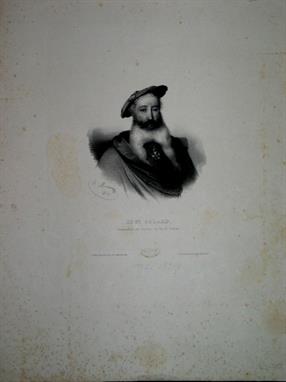70555 Preisdatenbank Los(e) gefunden, die Ihrer Suche entsprechen
70555 Lose gefunden, die zu Ihrer Suche passen. Abonnieren Sie die Preisdatenbank, um sofortigen Zugriff auf alle Dienstleistungen der Preisdatenbank zu haben.
Preisdatenbank abonnieren- Liste
- Galerie
-
70555 Los(e)/Seite
Louis le Brocquy HRHA (1916-2012) CHILDREN IN A WOOD II, 1991 lithograph on handmade Japan paper; (no. 8 from an edition of 75) signed and numbered in pencil in the margin lower left 20 by 26in., 50 by 65cm. L Sheet size: 22.5 by 30in.Printed by the Atelier Chave, Vence, 1991 in an edition of 75 (with 15 Hors de Commerce and 15 Artist`s Proofs).
An interesting collection of eight Victorian Banquet at Guildhall and Epping Forest coloured lithograph invitation cards to Lord Mayor of London published Blades, East & Blades, a similar menu card 1875, a Coronation Procession Grand Stand ticket with ticket stub - Block 8 seat no. 232 - four Worshipful Company booklets and other London ephemera, two copies of Freedom City of London dated 1851 and 1823 in original cylindrical capsules, together with a De La Rue Ltd ink pen, two desk top seals, one initialled the others with initials and elephant head surmounted with matching print plate
India and the Punjab - Maharaja Duleep Singh. Original Lithograph by J. D. Harding from the original drawing by the Honourable Charles Stewart Hardinge London^ 1847. Charles Stewart Hardinge (illustrator). This rare litho is a Plate from ""Recollections of India. Part 1. British India and the Punjab"" by James Duffield Harding^ 1847^ Lithograph measures 17"" x 13"". Showing a scene from the First Anglo Sikh War. Charles Stewart Hardinge (1822-1894)^ the eldest son of the first Viscount Hardinge^ the Governor General. This depicts the last Sikh ruler of the Punjab and son of Maharajah Ranjit Singh.
India Large rare Sikh War lithograph of the Battle of Sobraon 1848 engraved by J Harris after Henry Martens published 1848. Measures approx 24 inches x 19 inches. The Battle of Sobraon was fought on 10 February 1846^ between the forces of the East India Company and the Sikh Khalsa Army^ the army of the Sikh Empire of the Punjab. The First Anglo-Sikh war began in late 1845^ after a combination of increasing disorder in the Sikh empire following the death of Ranjit Singh in 1839 and provocations by the British East India Company led to the Khalsa invading British territory. The British had won the first two major battles of the war through a combination of luck^ the steadfastness of British and Bengal units and equivocal conduct bordering on deliberate treachery by Tej Singh and Lal Singh^ the senior commanders of the Khalsa. Few of these lithographs of the Sikh War series were published and can be seen in institutions such as the National Army Museum
India Large rare Sikh War lithograph of the Battle of Ramnagur 1851 engraved by J Harris after Henry Martens published 1851. Approx 24 inches x 19 inches. The Battle of Ramnagur was fought on 22 November 1848 between British and Sikh forces during the Second Anglo-Sikh War. The British were led by Sir Hugh Gough^ while the Sikhs were led by Sher Singh Attariwalla. Official British casualties were 21 killed^ 55 wounded and 9 missing. This may have referred to the 14th Light Dragoons only. Sikh casualties were not recorded. Sher Singh had skilfully used every advantage of ground and preparation. Although the Sikh forces had been driven from their vulnerable positions on the east bank of the Chenab^ their main positions were intact^ they had undoubtedly repulsed a British attack^ and the morale of Sher Singh`s army was boosted. Few of these lithographs of the Sikh War series were published and can be seen in institutions such as the National Army Museum.
India Large rare Sikh War lithograph of the Battle of Aliwal 1847 engraved by J Harris after Henry Martens published 1847^ approx 24 inches x 19 inches. The Battle of Aliwal was fought on 28 January 1846 between the British and the Sikhs. The British were led by Sir Harry Smith^ while the Sikhs were led by Ranjodh Singh Majithia. Few of these lithographs of the Sikh War series were published and can be seen in institutions such as the National Army Museum
Die Vereinigten Staaten von Nord-America This precisely engraved map was designed for a German emigrant guide book. In the west, it is largely drawn from Brue`s map of Mexico (1834). It shows the Republic of Texas depicted in its smaller configuration with its southern border along the Nueces River. The southwest is still shown as Mexican Territory. In the Pacific Northwest, the U.S./Canadian border reflects the American claims into present-day British Columbia. The huge Missouri Territory stretches between the Rocky Mountains and the large Northwest Territory, and between Canada and Texas - thus incorporating the region that would become Indian Territory. The region of the Great Basin does not show Fremont`s exploration and is marked Oede Sand Wuste (Desolate Sandy Desert). A color key assists in the location of eight of the smaller states in the Northeast. In the lower margin is an extensive legend of political and topographical features. This rarely seen map was engraved by J.E. Woerl and is an early lithograph by B. Herder from Freiburg. Issued folding, now flattened, with light soiling and foxing primarily along the folds, and backed with Japanese tissue to reinforce and repair numerous small fold separations. 18.5 W x 25.2 H Bromme, Traugott 1840
[Lot of 2] Mission of San Diego [and] San Diego from the Old Fort A. Mission of San Diego, by Charles Koppel, from Report of Explorations in California for Railroad Routes , circa 1856, hand color (8.8 x 6.5""). This charming scene of San Diego is one of the earliest printed views of the mission. The mission was the location of San Diego`s first military post and it was occupied by the Army from 1847 to 1857. This tinted lithograph is based on the drawing by Heinrich Moellhausen for the railroad survey by Lt. R.S. Williamson. Condition: A clean and bright example. (A) B. San Diego from the Old Fort, by C.B. Graham, circa 1848, black & white (6.7 x 4.4""). Published in Emory`s Notes of Military Reconnaissance from Fort Leavenworth, Missouri, to San Diego, California.... This is an early, Mexican War period view of San Diego. Condition: Minor foxing mainly confined to the left blank margin and some creasing at bottom. (B+) See description above. 1848-56
Los Angeles This is the first printed depiction of Los Angeles. The plaza is on the left with the San Gabriel Mountains in the background. At the right foreground on the hill is the former Mexican jail. Our Lady of the Angels church is at center. This lovely tinted lithograph was created for Robert S. Williamson`s report of his explorations in California for potential railroad routes. Attractive example with just a few tiny spots of foxing in the image. 7 W x 9.2 H Koppel, Charles 1856
A 1920`s Swedish coloured lithograph of a lynx in a winter landscape, after Nils Tiren, published by P A Norstedt & Sons, Stockholm, 73 x 97 cm (unframed) together with a framed flat-woven textile panel, a pair of Union Jack flags on wooden stretchers and a watercolour of an abstract landscape
-
70555 Los(e)/Seite




























![[Lot of 2] Mission of San Diego [and] San Diego from the Old Fort A. Mission of San Diego, by Charles Koppel, from Report of](http://lot-images.atgmedia.com/SR/36385/2906594/215-20145813032_468x382.jpg)
















![ALEX KATZ [US B. 1927], SCREENPRINT & LITHOGRAPH, 1976, H 28", W 21", "PAMELA IN BLUE" MICHIGAN OPE](http://lot-images.atgmedia.com/SR/33875/2905953/2019-201441617651_468x382.jpg)













